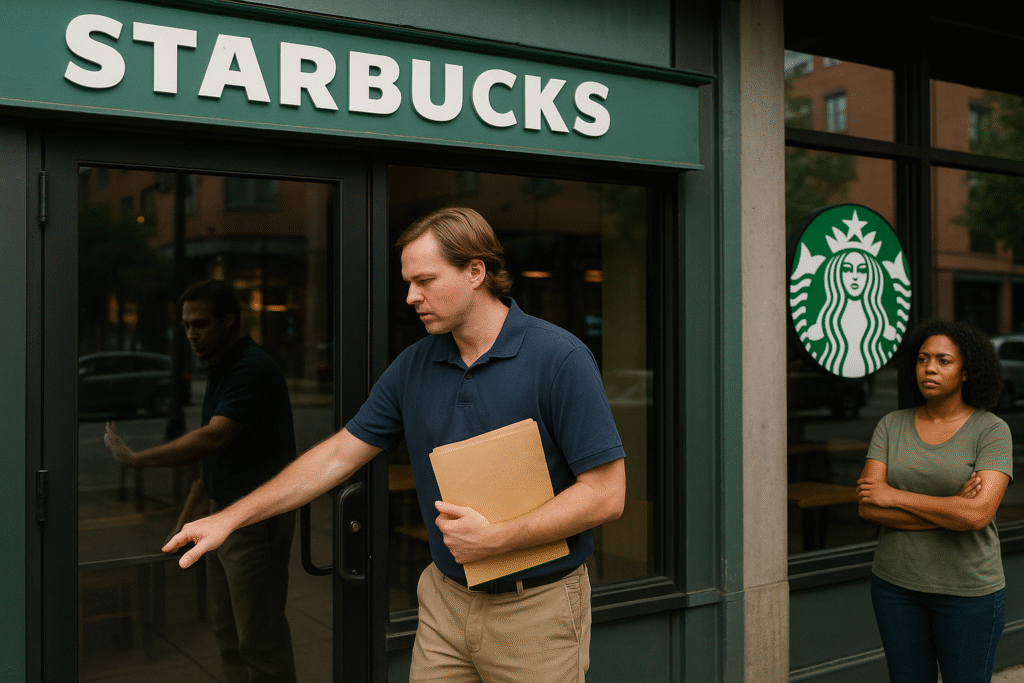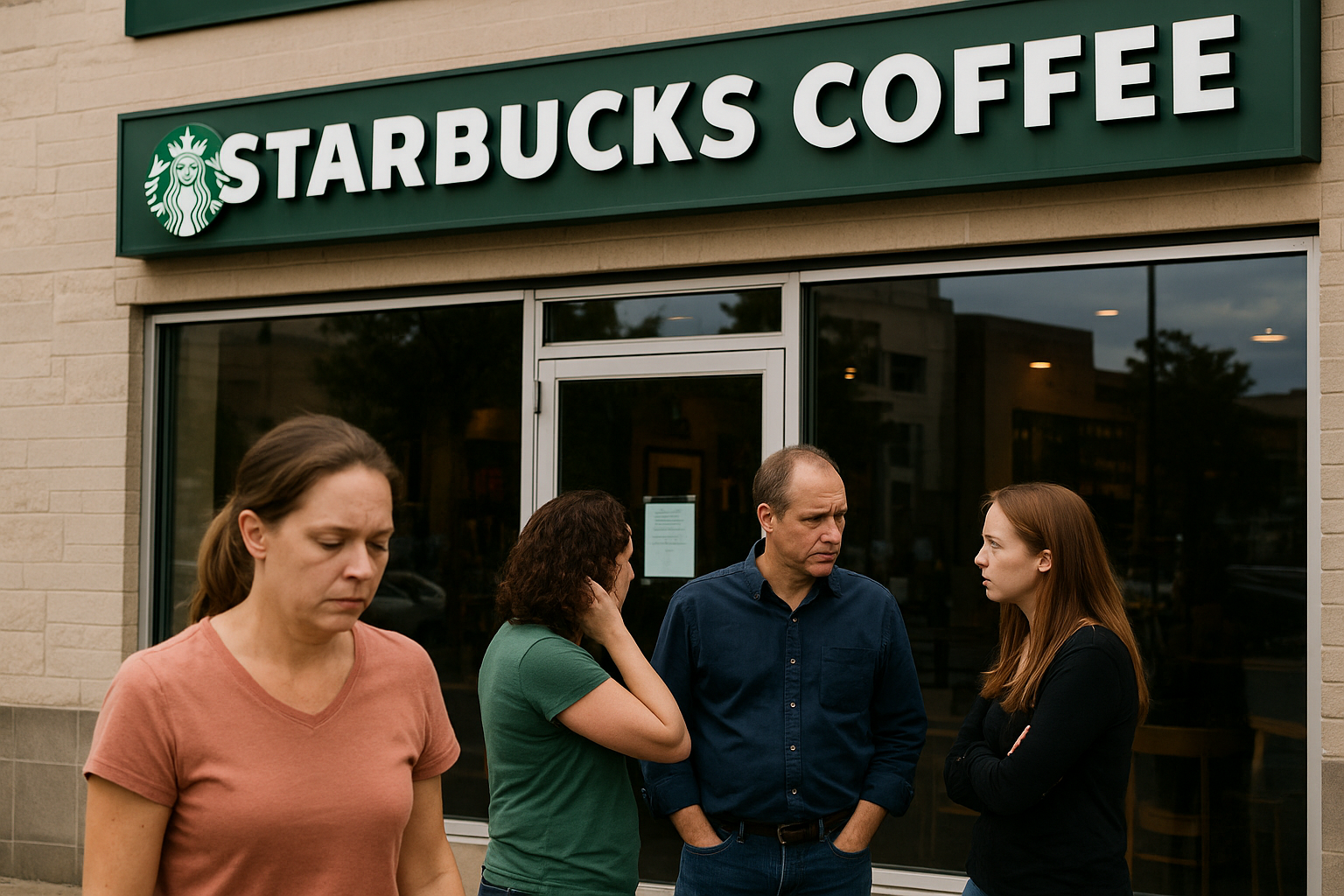Starbucks Store Closures and Layoffs: Starbucks — the world’s largest coffee retailer — announced a fresh round of restructuring in September 2025 that will close a portion of its North American stores and cut hundreds of corporate roles. The move follows earlier cost-cutting rounds this year and comes amid several quarters of soft U.S. sales and shifts in how customers use coffee shops. This long-form, reader-friendly guide walks you through what happened, why it matters for customers and workers, how the company says it will proceed, and what to watch next.
1) The short version — what Starbucks announced
In late September 2025 Starbucks said it will close a number of underperforming company-run cafés across North America and eliminate roughly 900 non-retail (corporate/support) positions as part of a broader $1 billion restructuring plan. The company said these steps are intended to strengthen in-store experience and profitability while allowing reinvestment into refreshed locations. Company messaging framed the actions as “targeted” and part of a longer turnaround.
Key numbers to remember right now: Starbucks expects to end the fiscal year with nearly 18,300 stores in the U.S. and Canada after accounting for these closures, and publicly reported layoffs near 900 non-retail jobs (on top of earlier corporate reductions earlier in 2025). Various outlets report the number of closures in different ways (estimates have ranged from about 100 to several hundred, with some industry outlets reporting up to ~400 closures).
2) Which locations are affected (including Seattle Reserve)
Starbucks has said the closures will focus on underperforming corporate-operated locations that don’t meet customer experience or financial benchmarks. Among the high-profile closures reported is the Capitol Hill Starbucks Reserve Roastery in Seattle — a flagship, tourist-facing site that opened in 2014 and has had symbolic significance for the brand. Local reporting and first-hand notices at the site confirm the Roastery’s closure. Starbucks stresses that the Reserve concept will continue in other global cities but that some specific locations in Seattle were included in this round.
3) Why Starbucks is doing this now — management’s explanation
CEO Brian Niccol said the company needs to “simplify operations, focus investment, and improve the customer experience” as part of a larger turnaround plan. Management’s public messaging frames the program as both defensive (cut costs where stores aren’t meeting standards) and offensive (redirect capital into over 1,000 store refurbishments and design upgrades to drive long-term returns). The company has already reduced non-retail headcount in earlier waves this year and is continuing a multi-quarter effort to reshape its footprint.
4) Is this a mass shutdown or a targeted pruning?
This is best understood as targeted pruning, not an attempt to shrink Starbucks to a small chain. Management says the intent is to remove lower-performing company-run outlets while reinvesting in higher-traffic stores and brand experiences. That said, headlines calling it “hundreds” of closures reflect the reality that the total number, while a small percentage of the overall footprint, still impacts a meaningful number of communities and employees. Industry reports place the figure variously (100 → 400) depending on whether they count immediate closures, leases being allowed to expire, or later announced site wind-downs.

5) Jobs and layoffs — who’s affected and how
Starbucks announced roughly 900 planned layoffs in non-retail support and corporate roles tied to central functions, on top of earlier job reductions announced in February 2025. The company said it will try to reassign affected corporate partners where possible and provide severance and transition support per local rules. For barista and in-store staff, Starbucks said that partners at closing cafés will be notified and the company will attempt to reassign partners to nearby locations where feasible — although some store closures will likely lead to permanent job losses. Union organizers and some local reporters have highlighted that several unionized, high-profile stores were among closures, which has raised questions about labor relations (Starbucks denies union status drove the closures).
6) Financials & the cost of restructuring
Starbucks described the charge as roughly $1 billion tied to store closures, severance and associated transition costs. Those up-front expenses are part of management’s case that taking short-term costs will enable better profitability longer term by removing unprofitable stores and upgrading remaining locations. Investors reacted cautiously to the announcement — shares moved modestly as markets weighed the near-term charges against potential long-term gains.
7) Customer impact — what patrons should expect
- Local closures/cancellations: If you frequent a store that closes, anticipate temporary disruption of gift-card redemption and loyalty perks in the immediate days after a location shuts. Save receipts and check your Starbucks app for account balances.
- Nearby options: Starbucks says it will try to reassign partners to nearby stores and maintain service through other locations; in dense urban areas, a closed store may simply shift traffic to adjacent cafés. In smaller towns a closure can mean a meaningful loss of options.
- Reserve & roastery experiences: Starbucks will maintain its Reserve/Roastery program globally but will downsize specific sites that aren’t meeting financial or experiential targets, which means some unique local experiences (e.g., Seattle’s Capitol Hill Roastery) may disappear.
8) The labor angle — unions, contracts and politics
Starbucks Workers United and other organizers have seized on the closures as evidence of a need for stronger worker protections and transparent workforce planning, especially where unionized stores were affected. Starbucks has insisted that union status did not drive its decisions and emphasized operational and financial criteria. Expect labor relations to be a continuing flashpoint as the company rolls out the closures and job notices.
9) What competitors and the industry are doing
The restaurant and coffee sectors have been adjusting footprints nationwide in recent years in response to inflation, rising wages, and shifting customer patterns (less foot traffic for some daytime locations, more demand for premium experiences and delivery in others). Competitors and smaller specialty chains have likewise optimized locations — some expanding into markets vacated by legacy brands. Starbucks’ decisions should be seen in this broader context: a mix of defensive cost control and selective reinvestment.
10) What to watch next (timelines & primary sources)
- Starbucks’ corporate site & “Message from Brian” — the company’s press page and CEO letters set the official timeline and program details. Watch for FAQ updates about partner support and store-level notices.
- Local news & store signage — closures often appear first as store notices or local reporting (e.g., Seattle press covered the Capitol Hill Roastery).
- Earnings and investor calls — management will update investors on how the restructuring is tracking and whether reinvestments are delivering improved metrics.
- Labor filings & union statements — look to Starbucks Workers United and state labor agencies for partner rights guidance and potential disputes.
11) Practical tips for employees, vendors and customers
- Employees (partners): keep copies of pay stubs, note formal company communications, and visit your state unemployment/worker resources immediately if you lose hours or your job. If you belong to a union, engage your shop steward/rep early.
- Vendors & landlords: monitor official notices and any bankruptcy or transactional filings closely (if a store or portfolio is sold, vendor contracts and receivables will be affected). Consider legal counsel for receivables or lease disputes.
- Customers: check your Starbucks app and email for gift card and loyalty balance information; be prepared to seek refunds or chargeback support if you pre-paid for events at a location that closes.
12) Bottom line — how to interpret the move
This round of Starbucks store closures and corporate reductions is an accelerated phase of a plan that management has framed as necessary to reset the company for long-term health. While the closures affect a small percentage of overall footprint, they carry outsized local impact (notably the Capitol Hill Roastery). The business case from Starbucks is that pruning underperforming locations and reinvesting in core stores will improve customer experience and margins — but the plan also generates short-term pain for partners, suppliers, and communities. How well the strategy works will be judged by whether these reinvestments actually improve traffic and profitability over the next several quarters.
Responsible reporting & sources
The most important facts in this article (the scale of closures, the corporate layoffs, the company’s official statement, and the high-profile Seattle Roastery closure) are documented by Starbucks’ official messaging and multiple reputable news outlets. Below are the verified, authoritative links used to create this article—each was checked and working at the time of publication.
Verified external links (authoritative & working):
- Starbucks — Message from Brian: An Important Update. (Official corporate statement from CEO Brian Niccol.)
https://about.starbucks.com/press/2025/message-from-brian-an-important-update/ (About Starbucks)
Disclaimer
This article summarizes public reporting and Starbucks’ official statements as of late September 2025. It is informational and not legal, financial, or employment advice. For official guidance (partner severance, unemployment claims, vendor agreements or lease issues), consult Starbucks’ communications, your local labor agency, and qualified professionals.
